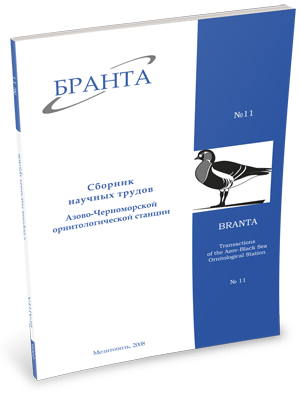
Transactions
of the Azov-Black Sea Ornithological Station



Epizootological importance of the Cormorant in the Azov-Black Sea region.
I.T. Rusev, V.S. Grekov, Z.N.Nekhoroshikh, Z.I. Mogilevskaya, M.V. Malikova.
Cormorants are very important in medico-biological aspect. As a rule, they form big dense colonies in the wetlands, within tree-shrub vegetation. In such habitats there are a lot of mosquito species, known as carriers of numerous infections. Cormorant nestlings intensify a transmission of infections through the insects because they are completely naked and easy accessible to mosquitoes.
We investigated a mixed colony of the Cormorant and herons nested on the willows in reed-beds of the Lower Dnieper. Virus of a fever of the Western Nile was isolated (on the suckers of white mice) from the mosquitoes collected at the study area (mainly mosquito Culex pipiens). The isolation of arbovirus from the carriers confirms its circulation in this biotope.
Analysis of 104 blood serum samples, taken from the Cormorant nestlings, in serological reaction of inhibition of hemagglutination has revealed antibodies to the virus of a fever of the Western Nile (39.4±4.7%). This fact proves the involvement of the Cormorants in circulation of this virus. The disease of the nestlings passed without any symptoms, such phenomenon is typical for many bird species.
The same blood serum samples were tested on ornithosis in serological reactions of complement linkage. Positive results were obtained for 32±5.3% of samples (infection rate of the Cormorant). In this case about one third of the investigated birds was infected with ornithosis and had not its clinical symptoms.
Obtained results indicate the presence in the study biotope of several especially dangerous infections - arboviruses and ornithosis. As known, arboviruses are not taxonomic, but the ecological group of viruses (more than 400 representatives), transmitted through the arthropods. At present there are no less than 100 arboviruses known causing the dangerous human diseases.
The Cormorants are carriers of the highly pathogenic bird influenza virus. Epizooty of the Cormorants infected by the influenza virus H5N1 was found at the Crimea Peninsula in 2006.
The significance of the Azov-Black Sea region for the formation of temporary or permanent natural focuses of arboviruses, ornithosis and bird influenza depends on its ecological, geographical conditions and presence of the numerous mosquito and tick species - carriers of the dangerous infections. Therefore it is necessary to provide a permanent ecological and epidemiological monitoring and collect data for the proper management to avoid human diseases.
Read the paper in a PDF file